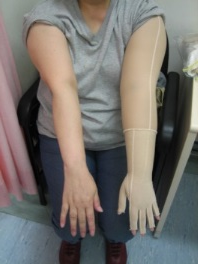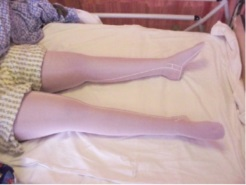About pressure garments
If necessary, healthcare professionals would recommend the use of pressure garments to reduce lymphoedema or prevent it from worsening as appropriate.
Occupational therapists will design and fabricate suitable pressure garments for patients according to the related body parts and extent of swelling. Pressure padding would be prescribed according to level of swelling and for scar management as indicated.
Wearing regime: Round the clock (except during shower) or following the instructions of the therapist.
How to take care of pressure garments:
- Change it every day
- Handwash with gentle detergent/washing powder in cold water and rinse properly; do not rub forcefully or wring them
- Refrain from using hot water or bleach; do not expose them to prolonged sunlight or iron dry
- Do not adjust the pressure garments on your own
Compression gloves and socks


*If you feel uncomfortable after wearing the pressure garment, such as itchiness or numbness, stop using it and notify your therapist for follow up as soon as possible.